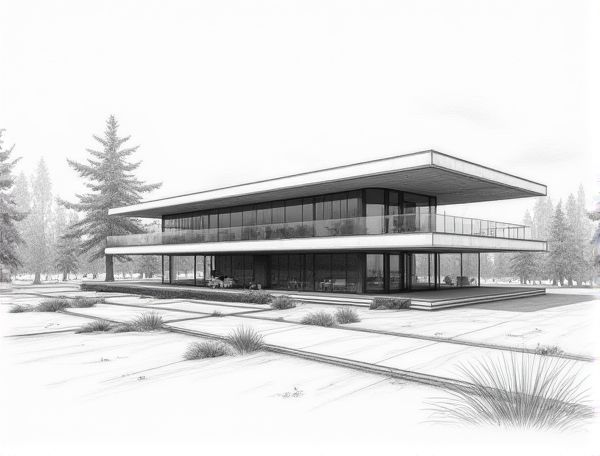
Photo illustration: Neo-futurist home design with electrochromic smart glass
Neo-futurist home design incorporates electrochromic smart glass to seamlessly blend cutting-edge technology with sleek, minimalist aesthetics, enhancing natural light control and energy efficiency. Discover how this innovative approach transforms living spaces for a futuristic lifestyle by reading more in the article.
Introduction to Neo-Futurist Home Design
Neo-futurist home design embraces innovative architecture with sleek lines, sustainable materials, and smart technology integration, creating living spaces that are both functional and visually striking. Your home can become a harmonious blend of futuristic aesthetics and eco-friendly solutions, enhancing comfort and efficiency. Emphasizing open layouts and dynamic forms, this style pushes the boundaries of traditional design to inspire creativity and modern living.
The Rise of Electrochromic Smart Glass
Electrochromic smart glass technology revolutionizes home design by allowing windows to tint on demand, enhancing energy efficiency and privacy while reducing glare and UV exposure. This innovation integrates seamlessly with smart home systems, offering homeowners precise control over natural light and indoor temperature to optimize comfort and sustainability.
Key Elements of Neo-Futurist Architecture
Neo-futurist architecture incorporates dynamic forms, sustainable materials, and cutting-edge technology to create innovative, eco-friendly living spaces that emphasize fluidity and functionality. Your home design can benefit from these elements by blending futuristic aesthetics with environmental responsibility and adaptive structures that enhance modern lifestyles.
Smart Glass vs. Traditional Windows: A Comparative Analysis
Smart glass enhances energy efficiency by dynamically controlling light and heat transmission, reducing HVAC costs compared to traditional windows that offer fixed insulation values. Traditional windows rely on static materials such as single or double-pane glass, while smart glass integrates electrochromic or thermochromic technologies, providing customizable transparency and privacy instantaneously.
Energy Efficiency and Sustainability with Electrochromic Glass
Electrochromic glass enhances energy efficiency by dynamically controlling solar heat and natural light, reducing reliance on HVAC systems and artificial lighting. Its smart tinting technology adapts to external weather conditions, contributing to sustainable home design with lower carbon footprints. Integrating this glass into Your home ensures both comfort and eco-friendly living by optimizing energy consumption year-round.
Enhancing Aesthetics: Modern Minimalism and Transparency
Modern minimalism in home design emphasizes clean lines, open spaces, and functional simplicity, creating an aesthetic that feels both elegant and uncluttered. Incorporating transparency through materials like glass walls and open shelving enhances natural light flow, making your living space appear larger and more inviting. This combination not only elevates the visual appeal but also promotes a calming and harmonious environment tailored to your lifestyle.
Integrating IoT and Smart Home Technologies
Integrating IoT and smart home technologies enhances energy efficiency by enabling real-time monitoring and automated control of lighting, heating, and security systems. Advanced sensors and connected devices create seamless user experiences, improving convenience, safety, and overall home functionality.
Customization and Personalization in Living Spaces
Customization and personalization in living spaces enhance comfort and reflect individual lifestyles, incorporating tailored furniture, color schemes, and spatial arrangements that optimize functionality. Integrating smart home technology allows for adaptive environments that respond to occupants' preferences, improving convenience and energy efficiency. Thoughtful design choices prioritize unique aesthetic elements and practical solutions, creating harmonious spaces that promote well-being and creativity.
Challenges and Future Trends in Neo-Futurist Design
Neo-futurist home design faces challenges such as integrating advanced technology without compromising aesthetic simplicity and addressing sustainability amid complex architectural forms. You must balance innovative materials and cutting-edge construction techniques with environmental impact and energy efficiency standards. Future trends include adaptive smart homes, biomimetic structures, and dynamic, transformable spaces that respond seamlessly to occupants' needs.
Conclusion: The Evolution of Intelligent Living Spaces
Intelligent living spaces have transformed home design by integrating advanced technologies such as smart lighting, automated climate control, and voice-activated systems that enhance comfort and efficiency. These innovations optimize energy usage and personalize environments, adapting seamlessly to Your lifestyle preferences. Embracing the evolution of intelligent living spaces ensures a future-proof home that prioritizes convenience, sustainability, and smart connectivity.
 homedesy.com
homedesy.com